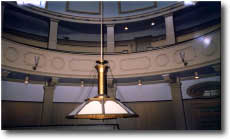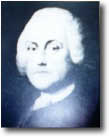

The Pennsylvania Hospital
Founded by Franklin in 1751

The indefatigable Franklin raised money to help found the hospital in 1751, in conjunction with Dr. Thomas Bond. When the United States declared independence from Great Britain, the hospital was already 25 years old. Franklin also served on the hospital's original Board of Managers, as well as being its first secretary and second president.

Initially, the basement was used to house the insane (Pennsylvania Hospital being a pioneer in the humane treatment of the mentally ill). The first floor of the Pine Building was the men's ward; the second floor the women's ward; the third floor was reserved for servants and for isolation cases of both sexes.
The first floor of the center building features the Great Court, an antique fire pump, a Thomas Sully portrait of former Board president Samuel Coates, and the President's office. Inside the office one can see a chair owned by William Penn, a grandfather clock built by the noted astronomer-scientist David Rittenhouse, and a Thomas Eakins portrait of Dr. Jacob DaCosta.
The second floor of the center building houses a historic library whose beauty will make any bibliophile's heart beat faster. Upon stepping inside one feels transported into a rarefied atmosphere (the room is climate controlled) and into another era. First one's eyes fall upon the darkly patinaed bookcases enclosed with hand-blown glass panes which accent the over 13,000 medical tomes and herbal and horticultural volumes contained within. The collection includes many outstanding works in anatomy, surgery, internal medicine, national history, science, and botany.

Though the bibliophile might be tempted to read at the great room-sized table another remarkable room awaits right above. Outside the library, portraits of doctors bearing solemn countenances give the area an art museum atmosphere. Seek out the portrait of the Declaration signing, yellow-fever fighting Dr. Benjamin Rush also painted by Thomas Sully. Sully, after Charles Willson Peale, was the leading portraitist of his time, and his legacy lives on in his many works on display at the National Portrait Gallery.

To the left of the Amphitheatre, in the West Wing, is the Museum of Nursing History. Nursing uniforms, pins, caps, and other memorabilia are on display.
North of the Pine Building is the Gallery Pavilion, where one will find Benjamin West's extraordinary 1817 painting "Christ Healing the Sick in the Temple." The hospital asked West to donate one of his works. He executed a painting in London, but it proved so popular that West was forced to leave it there and paint a similar work. When the second painting was hung in Philadelphia, overflow crowds paid to view it.
Before leaving, tour the grounds on the Pine Street side of the hospital. While strolling through the gardens, stop to appreciate the fine merging of Georgian and Federal architecture. The rotunda will put one in mind of Jefferson's Monticello. An 18th Century statue of William Penn presides over the gracious setting. A well-tended "physic" (an early term for "medicine") garden features herbs that were once used for therapeutic purposes. Azaleas and wisteria encountered on your walk date to the last century.
The grounds also contain the unmarked grave of Mary Girard, the wife of Stephen, who was one of the richest men in the country when he died. Mary was committed to the hospital as a "lunatic" in 1790, gave birth to a daughter a year later, and was a patient here until 1815. Stephen Girard's endowments to the hospital were substantial.



